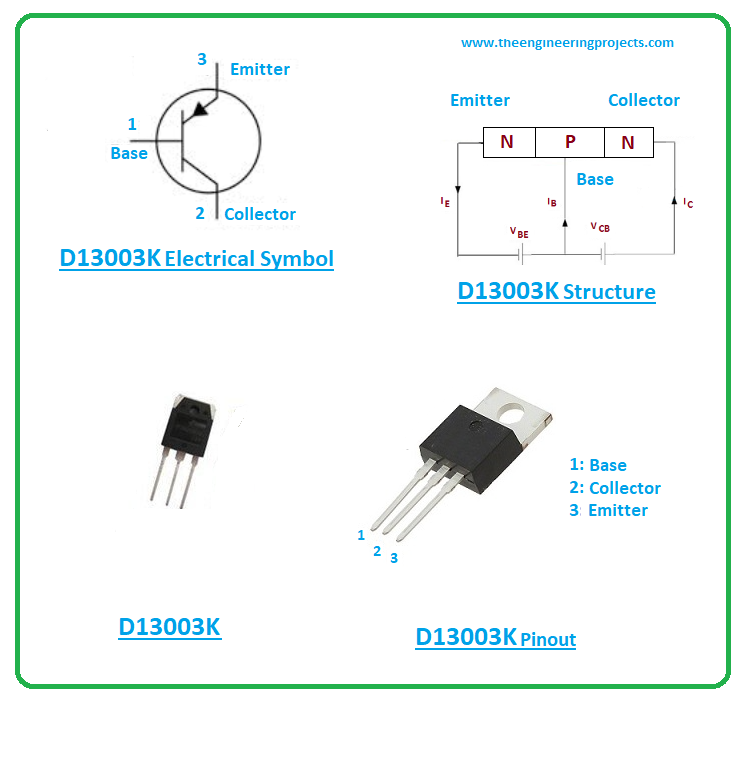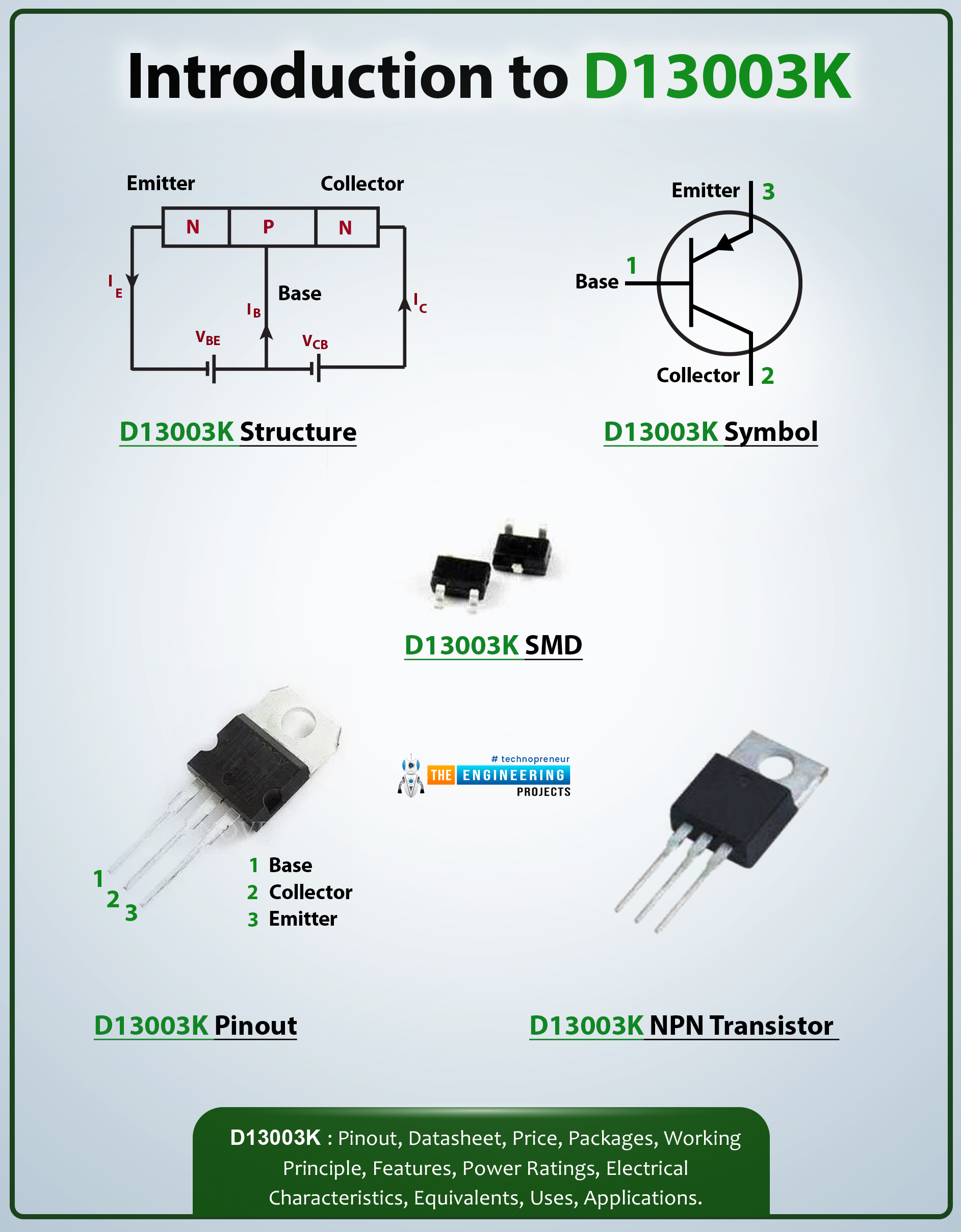
Hi Friends! I welcome you on board. Thank you for clicking this read. In this post today, I’ll document the Introduction to D13003K. The D13003K is an NPN silicon transistor mainly employed for switching and amplification purposes. It comes with a power dissipation of around 50W which demonstrates the amount of energy this device releases during the functioning of this device. As this is an NPN transistor as here electrons are the major charge carriers. The collector current is 1.8A which means it can support load under 1.8A. The emitter-base voltage is 9V which means it needs 9V to bias this device and start the transistor action. I suggest you read this post all the way through as I’ll walk you through the complete Introduction to D13003K covering pinout, datasheet, power ratings, working principle, applications, and physical dimensions. Let’s get started.
Introduction to D13003K
- The D13003K is a power transistor made of silicon material and falls under the category of NPN transistors.
- This device is composed of three layers where one is a p-doped layer that stands between the two n-doped layers.
- This component comes with three terminals known as collector, emitter, and base. All these terminals are different in terms of doping concentrations.
- The power dissipation of this device is 80W which is the amount of power released during the working of this device.
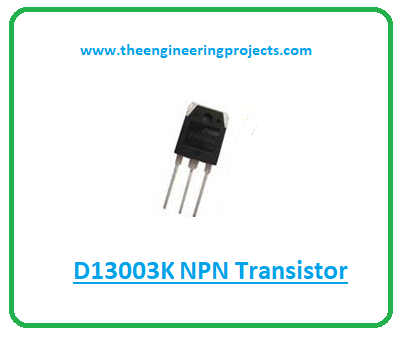
- The D13003K belongs to bipolar junction transistors where electrons are the major carriers. The bipolar junction transistors are divided into two main types NPN transistors and PNP transistors. In NPN transistors electrons are the major carriers while in the case of PNP transistors holes are the major carriers. They are called bipolar junction transistors because both electrons and holes are responsible for the conductivity inside the transistor.
- These bipolar junction transistors are current-controlled devices because a small current at the base terminal is employed to control large output current at the remaining terminals.
- The MOSFETs, on the other hand, are voltage-controlled devices that come with terminals named drain, source, and gate.
- The mobility of electrons is better than the mobility of holes the reason NPN transistors are preferred over PNP transistors for a range of applications.
D13003K Datasheet
Before you embed this device into your electrical project, it is better to scan through the datasheet of D13003K. The datasheet features the main characteristics of the device. Click the link below to download the datasheet of D13003K:D13003K Pinout
The following figure represents the pinout diagram of D13003K.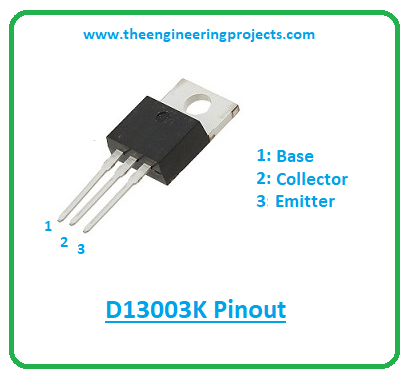
D13003K Working Principle
- The base pin plays a vital role to start the transistor action. When voltage is applied at the base pin, it will bias the device, and as a result, the current will start flowing from the collector to the emitter terminal.
- As this is an NPN transistor here current flows from collector to emitter terminal and in the case of PNP transistor current flows from emitter to collector terminal.
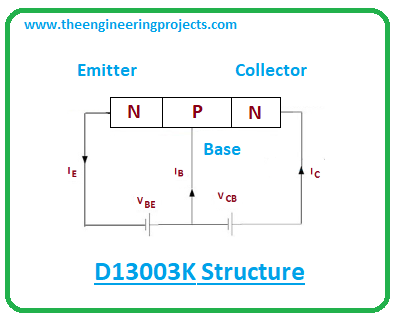
- These bipolar junction devices are not symmetrical in nature. And the different doping concentration of all three terminals is responsible for the lack of symmetry of this device.
- This means if we try to exchange emitter and collector terminals then the device will start working in reverse active mode, and stop working in forward active mode.
D13003K Power Ratings
The following table features the absolute maximum ratings of D13003K.| Absolute Maximum Ratings of D13003K | ||||
|---|---|---|---|---|
| Pin No. | Pin Description | Pin Name | ||
| 1 | Collector-emitter voltage | 400V | ||
| 2 | Collector-base voltage | 700V | ||
| 3 | Base-emitter voltage | 9V | ||
| 4 | Collector current | 1.8A | ||
| 5 | Power dissipation | 50W | ||
| 6 | Base current | 0.9A | ||
| 7 | Operating and storage junction temperature range | -55 to 150C | ||
- While embedding this chip into your project, make sure the ratings don’t exceed the absolute maximum ratings. Otherwise, it will put your entire project at stake.
- The junction temperature and storage temperature ranges from -55 to 150C.
- It is important to note that, don’t apply these ratings more than the required time, else they can affect device reliability.
- The collector-emitter 400 and collector-base voltage is 700. And total power dissipation is 50W which demonstrates that this device will release 50W energy during the working of this device.
D13003K Applications
D13003K is used in the following applications.- Used in a common power amplifier.
- Used in voltage regulator circuits.
- Used in electronic Ballasts.
- Used in Bistable and Astable multivibrators circuit.
- Incorporated in modern electronic circuits.
- Used in the high switching power supply.
- Used in high-frequency power transform.
- Employed to support loads under 1.8A.
- Used in energy-saving lights.



